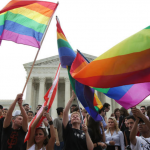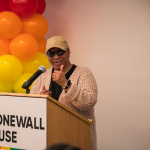We’re just about to put the wraps on LGBTQ+ Pride month – that time of year when marketers break out the rainbow flags, LGBTQ+ employees and allies groups march in parades, and alcohol ads in LGBTQ+ social media show us just how fun it is to be gay. This year it was also time to roll out the rainbow-labeled Absolut vodka to celebrate the Supreme Court’s unexpected decision protecting gay and trans people from employment discrimination as we celebrate the 50th anniversary of the first Pride parade.
But this year it was all different – LGBTQ+ Pride occurred at the societal confluence of the protests sparked by the killings of George Floyd, Breonna Taylor, and Ahmaud Arbery; the killings of two black trans women, Dominique Fells and Riah Milton, shortly after a black trans man, Tony McDade, was killed by the police; a pandemic that has disproportionately affected people of color; and an economic crisis that has disproportionately affected trans people.
And now marketers must finally decide whether they will face that pesky intersection of sexual, gender, and racial identities that they’ve either neglected or ignored since gay activists first manufactured the “Dream Market” to gain social progress in the 1980s. According to the Williams Institute, there are more than 1 million LGBTQ+ Black individuals currently living in the United States, with approximately 3.7% of the U.S. Black population identifying as LGBTQ+. Black LGBTQ+ people are disproportionately young and disproportionately female, and nearly one-third of all Black same-sex couples are raising children.
For decades, Black LGBTQ+ people have fallen between the cracks of the civil rights movement, the LGBTQ+ movement and, for Black lesbians and trans women, the Women’s Rights movement. Recent activism by #BlackLivesMatter and #BlackTransLivesMatter has finally challenged the analogy of blackness, queerness, and gender by centralizing all three in their critique of structural racism and police violence against black people. Black transgender women, who live at the intersection of all three identities, are killed so often that the American Medical Association has declared it an epidemic. At least 27 transgender people were murdered by brutal force last year; 91% of these victims were Black trans women, and 81% were under the age of 30, according to the Human Rights Campaign.
From Blindered Corporate Pursuit to AdvocacyAlthough Black trans women led the rebellion against police harassment at New York’s Stonewall Inn in 1969 that laid the foundations for the modern gay rights movement, people of color, women, and transgender consumers have been strategically ignored in the LGBTQ+ marketplace. The Gay “Dream Market,” as it was dubbed in 1991 by the Wall Street Journal, was created in the 1980s as part of a strategic effort by leaders of the gay social movement to achieve social progress through the marketplace. Over the next four decades, LGBTQ+ marketing agencies consistently touted the above-average household incomes, attractive buying habits, and strong brand loyalty of LGBTQ+ consumers, which by their own estimates, had reached a buying power of over $1.3 trillion in 2018. In reality, those buying power numbers drew heavily on the affluence of upper- and middle-class, white gay men, and marketers were happy to chase those dollars into gay bars, cruise ships, and exotic vacation spots.
During the 1990s tech boom, investors lauded their embrace of diversity as they provided $3M in funding to Planetout, an online media company exclusively targeting gay men. Funding for women and people of color was non-existent in the tech industry. Over the past decade, many prominent companies shifted from the “Corporate Pursuit” of the gay male market in the 2000s to “Corporate Advocacy” with cause-related marketed designed to influence the treatment of the LGBTQ+ population in public policy. In 2013, 379 corporations and employer organizations successfully urged the Supreme Court to strike down state bans on same-sex marriage (Barrett, 2015). In 2019, the HRC found that 88% of CEI-rated businesses met the standard of demonstrating at least three efforts of public commitment to the LGBTQ+ community – marketing, advertising and recruitment efforts, philanthropic contributions to LGBTQ+ organizations, LGBTQ+ diverse supplier initiatives, and public policy weigh-in – and have inclusive philanthropic giving guidelines. (Human Rights Campaign, 2018). In response, LGBTQ+ individuals have shown impressive brand loyalty to companies that are visible supporters or advocates of LGBTQ+ equality in their advertising.
Act Boldly for Social Change
The LGBTQ+ market is currently the fastest-growing consumer market in the U.S. and is on target to grow by millions in the U.S. in the next few years. This growth is primarily driven by 20% of Millennials and 31% of centennials (GenZ born after 1998) that identify as LGBTQ+. “Q+” represents individuals who do not define their sexual orientations and gender identities as anything other than “non-straight” and “non-binary.” Today’s LGBTQ+ consumers would interpret the “wink-wink” use of gay code in Subaru’s famous “Lezbaru” ads as a lack of conviction to LGBTQ+ people, their civil rights, and their right to be treated with legitimacy in the marketplace. These non-conforming Millennials and Gen-Z consumers are growing up without the stigma and lack of social legitimacy that defined previous generations of LGBTQ+ individuals. They are not looking to hide. Today’s Millennial and Gen-Z LGBTQ+ consumers, who live without boundaries, demand the same of marketers who seek their business.
Additionally, mainstream society has evolved on sexual and gender identity to make it a non-issue, especially among Millennials and younger consumers. Fifty percent of Millennials believe gender is a spectrum, and that some people fall outside of conventional categories. For its first ten years, Facebook limited its billions of users to identify as either male or female. In 2014, the ubiquitous social network that is somewhat of a social census, reconstituted gender categories beyond the oppressive binary and now offers nearly 60 different gender options, including “questioning” and “bigender” — or no gender at all. The Oxford English Dictionary recently included Mx, as a neutral replacement for titles like Mr. and Mrs. The video game “The Sims” has begun allowing players to create same-sex relationships and lifted gender restrictions on characters’ clothing and hairstyles.
Beyond gender, nine out of ten Millennials say that they will switch brands for a cause. In a 2018 survey by RetailMeNot, 66% of internet users ages 18 and older, and 77% of Millennials said more brands should take a public stand on important social values. Given the recent flurry of corporate activity to respond to social unrest, marketers can quite easily continue to check the boxes of Corporate Advocacy. They can release statements, make long-overdue changes to racist brand names, or join the month-long boycott against Facebook. In the current social climate, all are low risk but can be considered advocacy. But if marketers genuinely want to deliver on the empathy brand mandate during these turbulent times, they must evolve from the Corporate Advocacy of the previous decade to Corporate Activism, where activism is described as taking direct action to achieve a political or social goal. In this time of acutely disproportionate access to health care, racial justice, and economic well-being, marketers must be bold and courageous enough to lead social change – to mitigate bias, to truly feel empathy, and to act boldly; to move from the marketing de rigueur of Corporate Advocacy to the courage of Corporate Activism.
Last week, P&G and iHeartMedia joined forces to present “Can’t Cancel Pride: Helping LGBTQ+ People in Need,” a virtual event designed to help raise visibility and funds for LGBTQ+ communities most impacted by COVID-19. The one-hour special hosted by transgender actress Laverne Cox and iHeartRadio’s Elvis Duran addressed issues faced by the LGBTQ+ community—including an increased risk of being disproportionately impacted by COVID-19 and the Trump administration’s recent move to kill transgender protections in health care—and raised well over its goal of $5 million for a slew of LGBTQ+ organizations, including The Trevor Project, SAGE, and GLAAD. Marc Pritchard, Procter & Gamble’s Chief Brand Officer, put out the call for corporate activism when he said: “The [pandemic] has exposed the complex and significant obstacles facing the LGBTQ+ community. We must continue to fight hate and intolerance against all people while redoubling our efforts to elevate LGBTQ+ visibility and provide support for those in need.”
This generation of marketers is unlikely to see another social moment that cries out for them to be agents of change – to do something that others won’t, to stand up for those who are society’s punching bags, to give voice to those whose lives have such little value that their loss is still not worth reporting. Marketers must mobilize for Black LGBTQ+ people and provide them with the visibility that no social movement in history has afforded them. They must insist that “All Black Lives Matter.” And they must be the authentic voice that all consumers are seeking amid unprecedented societal uncertainty, chaos, and distrust.
This article originally appeared in Forbes on June 29, 2020.







